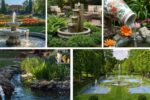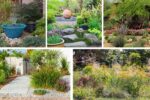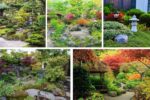Gardens are not just about aesthetics—they can also be a source of flavor and nourishment. Edible flower beds combine beauty and practicality, bringing vibrant blooms that can also be harvested for teas, desserts, or savory dishes. From colorful petals to fragrant herbs, these flower beds add a whole new dimension to gardening. Below are five creative edible flower bed ideas that balance elegance with functionality.
1. Herb and Edible Flower Combination Bed

Pairing herbs with edible flowers creates a stunningly fragrant and functional flower bed. Imagine a mix of basil, thyme, and rosemary alongside edible blooms like nasturtiums, marigolds, and pansies. The herbs offer culinary versatility, while the flowers add both color and edible garnishes for salads and drinks. Designing this bed in a raised or tiered style can make it both visually appealing and easy to maintain. This setup ensures that your garden is not only beautiful but also deliciously useful.
2. Salad-Inspired Flower Bed

A salad-themed flower bed is a vibrant mix of plants that can go directly from the garden to your plate. Lettuce, arugula, and spinach provide a lush green backdrop, while edible flowers such as calendula, violas, and nasturtiums bring bursts of color. The combination creates a cheerful, textured bed that doubles as a salad bar in your backyard. Beyond practicality, this design celebrates the harmony of flavors and aesthetics, making your garden both a feast for the eyes and a treat for your palate.
3. Tea Garden Flower Bed

For tea lovers, a flower bed designed with edible blooms and herbs perfect for brewing is both romantic and functional. Chamomile, lavender, hibiscus, and rose petals can be grown alongside mint and lemon balm to create a fragrant, relaxing tea garden. Arranging these plants in symmetrical or circular beds enhances the sense of tranquility. This edible flower bed not only offers visual beauty but also a daily supply of soothing teas, turning your outdoor space into a sanctuary of wellness and flavor.
4. Vertical Edible Flower Bed

Small spaces can still bloom beautifully with a vertical edible flower bed. Using trellises, tiered planters, or repurposed pallets, you can grow edible climbing flowers like scarlet runner beans or nasturtiums along with compact blooms like violets and pansies. This creative design maximizes space while creating a living wall of color and taste. The cascading flowers offer a whimsical look, and the edible harvest ensures practicality. Perfect for balconies or patios, this design merges sustainability with artistry.
5. Seasonal Rotating Edible Flower Bed

A rotating flower bed keeps your garden dynamic, colorful, and edible all year long. Plant cool-season blooms like pansies, violas, and calendula in spring, followed by summer favorites like nasturtiums and sunflowers. As autumn arrives, add chrysanthemums and marigolds to keep the garden glowing. Each season, your bed remains both visually stunning and harvest-ready. This approach keeps your landscape fresh while ensuring that your kitchen always has a supply of edible blooms for garnishing, teas, or cooking.
Final Touch:
Edible flower beds prove that gardens can be more than just decorative—they can also be delicious. Whether you’re creating a salad bed, a tea garden, or a rotating seasonal display, these ideas bring flavor and function to your landscape. With the right mix of flowers and herbs, you can enjoy a garden that looks good, smells divine, and tastes even better.





Leave A Comment